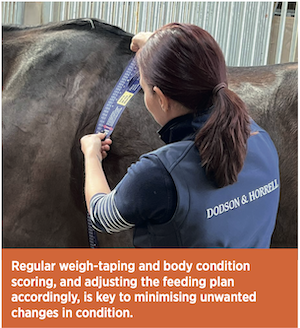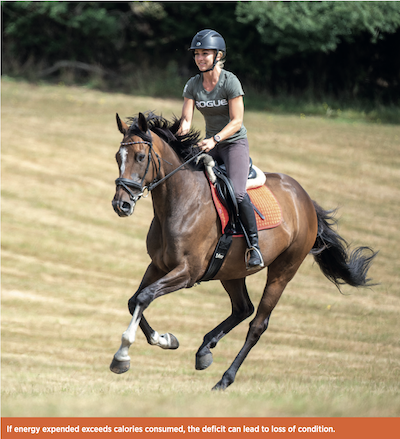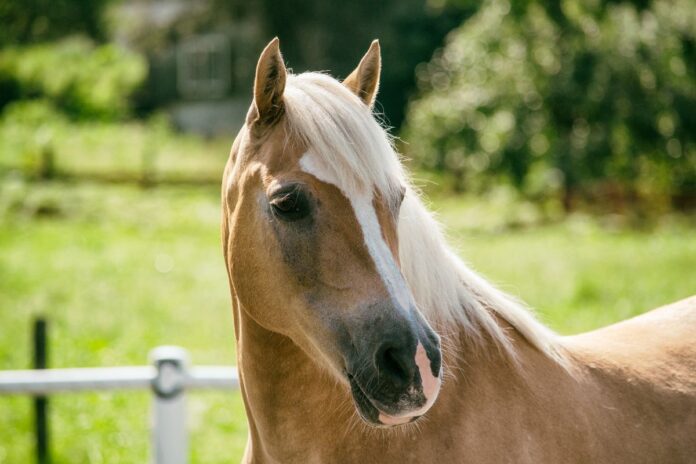FEEDING FOR BEST CONDITION

By Laura Wilson BVM&S MRCVS, technical advisor, Dodson & Horrell
AMTRA is required by the Veterinary Medicines Regulations to ensure its RAMAs/SQPs undertake CPD. All RAMAs/SQPs must earn a certain number of CPD points in a given period of time in order to retain their qualification. RAMAs/SQPs who read this feature and submit correct answers to the questions below will receive two CPD points. For more about AMTRA and becoming a RAMA/SQP, visit www.amtra.org.uk
Whilst a lot of what we see and read is currently focused on addressing the equine obesity epidemic in the UK, there are still many horses out there that have the opposite issue and can struggle to maintain their weight.
For horses and ponies in both these categories, getting the balance right can be a challenge. Keeping track of body condition and body weight, especially during changes in routine, can help to detect early fluctuations before they become difficult to manage.
Using a weigh tape to measure bodyweight every fortnight and keeping track of body condition score at these set intervals is a simple way to start monitoring and make dietary adjustments accordingly.
FORAGE
Forage is the mainstay of any good equine diet and horses should be fed a minimum of 1.5% of their bodyweight (dry matter) daily to maintain digestive health (unless in extreme cases under direction of a veterinary surgeon). As such a large proportion of the diet, it’s role in weight management cannot be underestimated. It is not only important to know the weight of forage a horse is eating each day when working towards weight loss, gain or maintenance goals, but also its nutritional value.

Not all forages are created equal and forage analysis can play a key role in allowing us to understand more accurately exactly what our horses are receiving. It enables an assessment of the suitability of the current forage for the requirements of the individual and can take some of the guesswork out of just how much they should be fed each day.
For horses in hard work or that struggle to maintain their weight, a forage which is higher in digestible energy and protein is ideal; whereas for those looking to reduce their body condition score, lower levels of protein and digestible energy are advantageous.
The fibre within forage can also be split into different types; digestible fibre (mostly cellulose, hemicellulose) and indigestible fibre (lignin). Some level of indigestible fibre (neutral detergent fibre) is important to maintain gut health, however levels towards the lower end of the optimum range are useful when working towards weight gain goals or to fuel higher levels of activity.
Conversely, forages with a proportion of indigestible fibre towards the upper end of the optimum range are ideal for those individuals with lower energy requirements or working towards weight loss goals. Forage analysis also provides an accurate assessment of the forage dry matter (the forage that is left once the water content is removed). This can guide the weight of total forage that should be fed each day.
BETTER OPTION
Contrary to popular belief, hay is not always a better option for horses that are looking to lose weight as its higher dry matter content (and therefore lower water content) can mean it is a more concentrated source of calories. Hay can often be a good option, however, as it can be soaked for 3-6 hours prior to feeding to reduce its sugar (water soluble carbohydrate) content.
The contribution of grass to the total diet should never be underestimated and should be factored into the daily forage allowance. A horse with unrestricted access to grass can consume up to 5% of their bodyweight in a 24-hour period, and therefore access may need to be restricted for those with weight loss or even maintenance goals; year-round for some and during the spring and summer months when grass growth rates and its nutritional content is highest for others dependant upon their individual needs and current body condition.
This may be in the form of stabling for an amount of time each day, alternating with turnout in a sand school or similar with access to soaked hay in a net, strip or tracked grazing or the use of a grazing muzzle. Top tip: When using a grazing muzzle for the first time it is important to check that the horse can drink without issue while wearing it.
INDIVIDUAL’S NEEDS

When choosing complementary feeding products, the individual’s needs must again be considered carefully. UK forage only diets can provide adequate energy for many horses in the UK, even up to a medium workload, however they will almost always be deficient in key vitamins and minerals. Copper, manganese, zinc, selenium, iodine and B vitamin levels often fall furthest below the recommended daily intake values.
Therefore, it is recommended that every horse should receive a vitamin and mineral supplement or a suitable balancer as a minimum in addition to a forage-based diet. For horses and ponies that are good- doers and looking to maintain their weight or lose weight, this diet it ideal to meet their nutritional needs while minimising calorie intake.
LOSING WEIGHT
For horses or ponies that are losing weight or struggling to maintain their weight, if this is a sudden or recent change the first step should be to discuss this with a veterinary surgeon and schedule a health check to ensure there are no underlying health concerns, before assessing the current diet and routine to look for changes that might have triggered weight loss.
It is not uncommon for some busy performance horses to struggle to hold condition through the competition season. The first check to make in this case is to ensure sufficient energy is being fed. All food stuffs have a calorific value - the level of energy that they provide. Weight loss can be simply down to an energy deficit - when a horse is expending more energy than it consumes. The more work a horse or pony is in, the more calories they will need to maintain their condition and warm weather can increase energy expenditure further.
Offering ad-lib forage, the opportunity to graze on good quality pastures as often as possible and potentially increasing the amount of concentrate feed being given, or switching to a performance level product with a higher digestible energy content are all possible changes that could be made to increase energy intake.
Products higher in carbohydrates (starch and sugar) will provide more 'fast release' energy, while those lower in carbohydrates and higher in oil and protein will provide more 'slow release' energy - great for stamina, naturally hot-headed horses and those which are prone to gastric ulceration or tying-up.
WINTER MONTHS
A common time of year for weight loss issues is during the winter months. It is natural to see a small downward fluctuation in condition during the winter which is then regained during the spring and summer months. For those looking to maintain their current condition this should be a change of no more than 1 on a 9-point condition scoring system or 0.5 on a 5-point system.
Again, at this time of year, weight loss is often due to an imbalance in the energy being eaten vs the energy being expended. In this scenario however, it is often due to a reduction in energy intake due to the nutritional content and rate of grass growth being lowest at this time of year. If we fail to compensate adequately for this in a horse's overall diet by adding energy in the form of preserved forages such as hay or haylage or adding complementary feed stuffs on top of this where necessary, an energy deficit will occur.
OLDER HORSES
Sometimes, despite offering preserved forages, older horses and ponies in particular can struggle. This can often be due to poor dentition (regular check-ups with a vet or suitably qualified equine dental technician are key) causing them to have difficulty chewing and breaking down the long strand fibre sufficiently prior to swallowing, limiting digestion and the amount of energy they are able to gain. These dental issues can, in some cases, also limit the volume of preserved fibres they are able to eat.
COMMERCIALLY AVAILABLE
There are many commercially available fibre-based products such as short chop fibres, high fibre wet feeds or mashes, and high fibre cubes that can fed as they are or soaked prior to feeding. Partial or total forage replacement diets are now possible and will often use a combination of these products. The respective feed company's helpline may even be able to provide their recommended tried-and-tested recipe!
For any further energy required beyond this, low starch and sugar, high oil and protein products are best during the golden years to help maintain condition and muscle mass.
Feeding for optimum condition can be a challenge at both ends of the spectrum and picking up subtle changes early through regular weigh-taping and body condition scoring and adjusting the feeding plan accordingly is key to minimising unwanted changes in condition and making progress towards weight loss or gain goals.

ABOUT ETN’S RAMA/SQP FEATURES
ETN’s series of CPD features helps RAMAs (Registered Animal Medicines Advisors/SQPs) earn the CPD (continuing professional development) points they need. The features are accredited by AMTRA, and highlight some of the most important subject areas for RAMAs/ SQPs specialising in equine and companion animal medicine.
AMTRA is required by the Veterinary Medicines Regulations to ensure its RAMAs/SQPs undertake CPD. All RAMAs/SQPs must earn a certain number of CPD points in a given period of time in order to retain their qualification. RAMAs/SQPs who read this feature and submit correct answers to the questions below will receive two CPD points. For more about AMTRA and becoming a RAMA/SQP, visit www.amtra.org.uk











